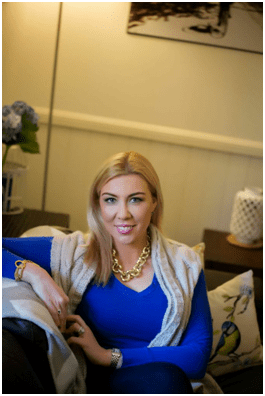Ever feel different? Like you don’t fit in, people are staring at you?
Ever sit at your desk thinking people are on to you and that they know you don’t really deserve to be where you are?
You wouldn’t be alone. Even Facebook COO Sheryl Sandberg has declared she has days at work when she feels like a “fraud”.
But how would you cope with such feelings if you’d spent your childhood labeled as “weird”, “ugly”, “beetroot head” and “tomato face”?
Brisbane-based consultant Kate Middleton was born with a benign hemangioma below her right eye, leading her to be relentlessly teased at school and judged by others for looking different.
Kate at 1 year old
Now 33, she’s learnt a lot about ‘imposter syndrome’ and the fear of failure, and says she’s in a good position to help women get the confidence they need to push through such feelings and use their competence to excel.
She describes her career as being a, “daily, conscious shedding of my older internal dialogue”, especially while sitting in boardrooms surrounded by powerful men. She’s spent 12 years in male-dominated environments, predominantly in financial services, having worked her way up from the call centre of Suncorp into project management and later leading on major change management programs.
“I had to learn to push through the tendency to judge myself and hold myself back,” she shares with Women’s Agenda. “I learnt to trust the merits of my work and not buy into scarcity thinking. With each promotion, successful project, person I helped develop and big win at work, I realised that I am not the sum of other people’s assumptions. I have real, demonstrated capability and a purpose in this world.”
Middleton founded a business called Career Oracle when she realised the number one thing holding her friends, colleagues and team members back appeared to be a lack of confidence in their own ability. “For me, the driver was more that I was surrounded by all these beautiful, amazing and capable women and promotions would come up and they wouldn’t even put their hands up,” she says.
Kate now, at 33
She believes it saw them coming up with excuses to explain and delay putting themselves forward, things such as: “I will do that when the kids get older”, “I should get some more experience before I apply”, or “maybe I should go for a more junior role and work my way up.”
It’s not necessarily a matter of self-esteem, she says, but rather a tendency to be modest. “I actually think it comes back to humility. We want to be nice and we want to be liked and we don’t think it’s sexy or modest to talk yourself up. It can seem abrasive, or blokey or too ‘salesey’,” she says.
Middleton now sees an average 18 female clients a month, while also working with a major corporate on a Diversity & Inclusiveness program.
She suggests the following four tips for getting more confidence and highlighting your competence:
1. If you can’t trust yourself, trust the facts
Let’s face it; we are all pretty good at focusing on what we’re not good at. The trick to re-writing your dialogue is to get clear on what your proven accomplishments are.
Print out your resume, go through each of your roles and highlight your top three accomplishment. You will probably feel silly and uncomfortable at first, but I guarantee it works.
Keep it light and positive, no matter how small, what made you feel proud? Did you receive some positive feedback? Your accomplishments could be anything from writing a procedure manual, to implementing a new system.
Once you have identified your achievements, work these scenarios into your resume and cover letter.
2. Numbers, Examples & Stats are King (or should I say Queen)
Now that you have identified your examples, quantify the accomplishment. Organisations love facts. In a data driven age, businesses want to know how you can add value to their company. Perhaps you improved a process and reduced a turn-around time by three days, or maybe you on-boarded a new major client resulting in a $1.2M increase in revenue. Back up your statements of achievement with numbers, percentages and facts.
3. Build your brand
I cannot stress this enough. Your personal brand messaging must be clear and consistent. This is the easiest way to build (or destroy) credibility. Additionally, if you still do not feel comfortable talking about your prior experience, let your profile do the talking for you.
Before sending out your resume or going for a promotion make sure you update your LinkedIn profile with the achievements you highlighted in Step 1 & 2. Also, ensure you have a great profile picture, sure it’s wonderful that you take a great selfie, but is that the brand message you want to send?
Consistency across your LinkedIn profile and resume builds a feeling of credibility, and credibility is a great baseline for building a positive business relationship.
Final tip: check the privacy settings on your social media accounts. It’s amazing how many people have never googled themselves. Be selective about the posts and pictures that appear on your public timeline.
4. Research and Customise
When you are finally ready to embark on a new opportunity, be deliberate in setting the tone and creating a dialogue.
A great cover letter should read like a conversation. It’s your pitch on a page. Like any great conversation your cover letter cannot be all about you. Show that you have researched the company. Explain why you would like to work there, how your values align, a particular project the company ran that you admired. Then once again, weave in the examples of your prior accomplishments that relate to the new role. Personalising your letter and talking about your accomplishments will build a great open dialogue with the hiring manager, and set the tone for your interview by creating a positive message straight up!



